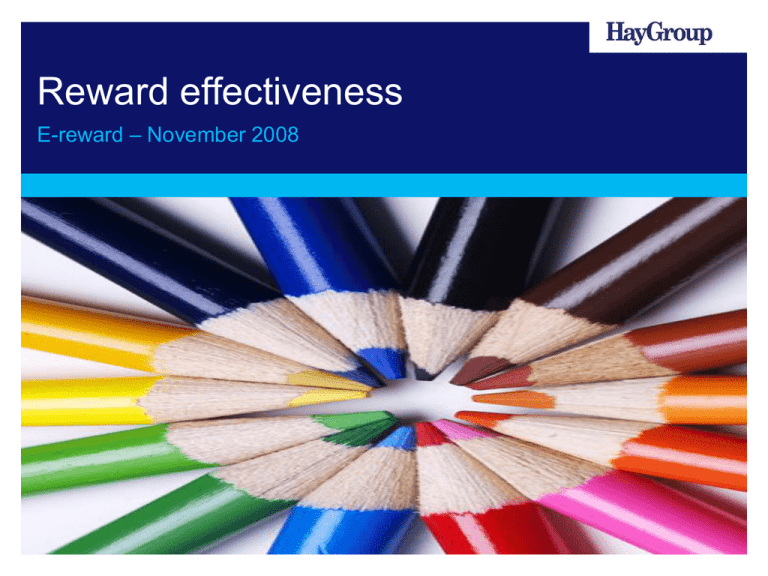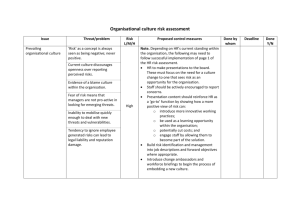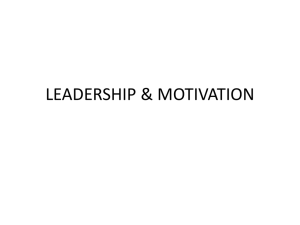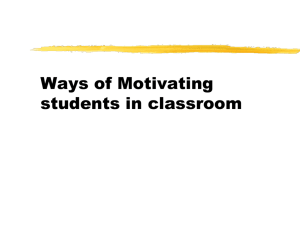
Reward effectiveness
E-reward – November 2008
Agenda
Research – Fortune Most Admired Companies
Reward strategy and design
Reward implementation
Pay differentiation
Communication
Role of line manager
Evaluation of effectiveness
© 2007 Hay Group. All Rights Reserved
2
Fortune survey of Most Admired
Companies
What is it?
Study of corporate reputations
Candidates: Fortune 1,000 and Global 500 companies
Separate rankings of the World’s and America’s Most Admired Companies (WMAC and
AMAC)
Companies rated both overall and relative to their industry peers
In determining industry rankings, AMAC companies are rated on 8 key attributes and
WMAC companies are rated on 9
© 2007 Hay Group. All Rights Reserved
3
Fortune survey of Most Admired
Companies (cont’d)
Attributes:
1.
Ability to attract and retain talented people
2.
Quality of management
3.
Quality of products or services
4.
Innovativeness
5.
Long-term investment value
6.
Financial soundness
7.
Wise use of corporate assets
8.
Social responsibility to the community and the environment
WMAC Only:
9.
Effectiveness in conducting business globally
© 2007 Hay Group. All Rights Reserved
4
Key differentiators of Most Admired
Companies
What distinguishes the “best” from the rest?
Our research has focused on:
Ability to attract and retain talent
Culture
Leadership
Performance management
Strategy implementation
Managing through economic uncertainty
Execution
Innovation
Effectiveness in conducting business globally
Board governance and human capital management
© 2007 Hay Group. All Rights Reserved
5
Research methodology: reward program
effectiveness
This year we chose to study whether there were distinctions in how Most Admired
companies managed their reward programs (i.e., were there things being done to help
ensure a greater return on investments?).
We surveyed executives in a sample of the organisations (over 160) that participated in
the 2008 Most Admired Companies rankings on a wide range of reward-related topics.
We then compared results for Most Admired Companies with the results for peer
companies.
To further develop our findings, we also conducted interviews with executives in
selected Most Admired Companies to gather additional insights into their strategies for
managing reward investments.
© 2007 Hay Group. All Rights Reserved
6
Topics covered: reward program
effectiveness
Reward
Strategy
and Design
Reward
Program
Implementat
ion
Evaluation
of
Effectivenes
s
We sought perspectives from Human Resources executives as well as senior leaders in
other line and staff management roles.
And we asked those completing the survey to think of rewards in the broadest terms,
including monetary as well as nonmonetary elements.
© 2007 Hay Group. All Rights Reserved
7
Reward strategy and design
Reward strategy
Global, centralised approaches are key…
Peer Group
Most Admired
We have a clearly defined global
approach to performance management.
93
74
81
We have a clearly defined global
compensation strategy.
70
Our compensation structures are
centralised (emphasising consistency in
market comparators, positioning strategy
and incentive eligibility).
83
55
0
10
20
30
40
50
60
70
80
90
100
% Agree
© 2007 Hay Group. All Rights Reserved
9
Reward strategy
…and the Most Admired seem to stay the course
Peer Group
Most Admired
79
Reward program reinforces a
consistent global philosophy,
strategy, and design.
67
Reward program has been stable
(i.e., not changed significantly)
over the last five years.
58
36
0
10
20
30
40
50
60
70
80
90
100
% Agree
© 2007 Hay Group. All Rights Reserved
10
Managing performance and rewards
Rewards are linked to performance
Peer Group
Most Admired
Strong linkage between reward
program and corporate
performance.
56
43
Strong linkage between reward
program and business unit or
team performance.
44
43
Strong linkage between reward
program and individual
performance.
41
36
0
10
20
30
40
50
60
% Strongly Agree
© 2007 Hay Group. All Rights Reserved
11
Performance measures
Performance measures are . . .
Peer Group
Most Admired
63
Clear and understandable
36
61
Challenging
39
39
Realistic and achievable
11
0
10
20
30
40
50
60
70
% Agree
© 2007 Hay Group. All Rights Reserved
12
Performance measures
Balance of Short-term vs. Long-term Focus
Peer Group
Most Admired
Your performance measures
encourage you to think not just
short term (e.g., this year’s
performance ) but into the future.
81
43
0
10
20
30
40
50
60
70
80
90
100
% “To a Very Great Extent”
Balance of Individual, Team and Corporate Measures
Peer Group
Most Admired
Your performance measures
encourage cooperation and
collaboration among senior
executives in your company.
81
43
0
10
20
30
40
50
60
70
80
90
100
% “To a Very Great Extent/To a Great Extent”
© 2007 Hay Group. All Rights Reserved
13
Reward strategy and design
Strive to be more inclusive and show alignment across regions, business units and/or
functions
Take the necessary time and work diligently to build your reward platform - then, over
time, fine tune rather than make wholesale changes
Ensure you include, promote and leverage intangible as well as tangible rewards
Balance types of measures – financial, customer, operational, human capital
Balance short-term and long-term objectives
Balance individual, team and corporate objectives
© 2007 Hay Group. All Rights Reserved
14
Reward program implementation
Strategy implementation
Most Admired Companies do a better job of implementing
their strategies
Peer Group
Most Admired
How effective would you rate the
implementation of your
company’s business strategy?
71
47
0
10
20
30
40
50
60
70
80
90
100
% “Very Effective”
© 2007 Hay Group. All Rights Reserved
16
Pay differentiation
% pay difference: MACs vs. peers
Most Admired Companies generally pay less…
6
4
2
Average = 5%
less for Most
Admired
Companies
0
-2
-4
-6
-8
Junior jobs
© 2007 Hay Group. All Rights Reserved
Senior jobs
17
Pay differentiation
There is significant variation in:
Peer Group
The frequency of promotions between
superior and average performers.
Most Admired
86
79
Annual incentive payouts between superior
& average performers.
74
72
Annual salary levels between superior &
average performers (i.e., at least 10%
difference).
71
62
Total remuneration between superior &
average performers (at least 10%
difference).
71
66
0
10
20
30
40
50
60
70
80
90
100
% Agree
© 2007 Hay Group. All Rights Reserved
18
Pay differentiation
You can increase your reward ROI via greater differentiation in pay
But, forced distributions, redesigned forms and changes in rating scales are superficial
You need managers who see merit and incentive pools as investments – vs. staff
entitlements – and who are trained and prepared to make the tough calls
Money talks, so secure funding and consider supplementary programs
Set and be clear with staff about performance-rewards linkages (i.e., alignment)
© 2007 Hay Group. All Rights Reserved
19
Reward communications
Reward
philosophy and
strategy
Project /
program launch
communication
s
Reward Program
Communications
Senior
leadership
reinforcement
of key
messages
© 2007 Hay Group. All Rights Reserved
Reward policies
and procedures
Total reward
statements
Individual
manager/
employee reward
communications
20
Reward communications
“My organisation has a
reward philosophy.”
91%
62%
% of employees who
understand it?
35%
True
28%
37%
Have a written
philosophy
All Companies
Most
Source: Hay Group, Loyola University Chicago, WorldatWork (2002)
© 2007 Hay Group. All Rights Reserved
About
Half
Less
Than Half
21
Reward communications
Peer Group
We regularly reinforce our reward
philosophy in communications with
employees.
Most Admired
82
64
Employees understand & appreciate
that rewards consist of tangibles and
intangibles.
0
74
61
10
20
30
40
50
60
70
80
90
% Agree
© 2007 Hay Group. All Rights Reserved
22
Reward communications
The seemingly “best” programs or the most sophisticated designs fail if they’re not
properly rolled out – communications is key to effective implementation.
Consider key messages, messengers, mediums and audiences.
Develop a course of action that weaves reward program messages into the fabric of the
organisation
Practice “strategic redundancy” – over-reach rather than under-reach
Start using total reward statement if not doing so already
Engage line managers – early and often
© 2007 Hay Group. All Rights Reserved
23
The role of line managers
Peer Group
Most Admired
Our compensation strategies have
been effectively communicated to
line managers.
83
63
0
10
20
30
40
50
60
70
80
90
100
% Agree
Employees also tend to trust the information from their line managers more than other
formal management roles.
Managers have the most influence over the array of intangible rewards the organisation
provides. It’s often the intangible rewards that are the primary vehicles in attracting and
retaining talent.
Managers are acting in roles previously held by HR.
© 2007 Hay Group. All Rights Reserved
24
The role of line managers
Line managers in your organisation are effective in the following areas:
Peer Group
Creating a positive work climate.
41
21
Understanding the concept of total rewards.
28
13
Implementing & communicating the total
rewards program.
23
11
Utilising financial & non-financial
recognition programs.
28
16
Reviewing/assessing employee performance.
19
Coaching employees & providing development
feedback related to their performance.
13
0
5
Most Admired
29
23
10
15
20
25
30
35
40
45
% “Strongly Agree”
© 2007 Hay Group. All Rights Reserved
25
Impact of a positive work climate
Hay Group research has shown that 30% of variance in business results
can be explained by differences in work climate created by the manager
Work Climate Dimensions
Flexibility
Responsibility
Standards
Authority delegated
Accountable for outcome
Emphasis on performance
Challenging/attainable goals
Rewards
Good performance recognised
Differentiated rewards
Clarity
Expectations clear
Expectations linked to mission
Commitment
© 2007 Hay Group. All Rights Reserved
No unnecessary rules
New ideas are accepted
Proud to belong
Discretionary effort
26
The role of line managers
Line managers are acting in roles previously performed by HR professionals – they
need to be better informed, educated and prepared.
HR has a critical role to play in facilitating managers’ success and leveraging best
practices across the organisation.
Managers need to understand and promote a “total rewards” view and approach when
dealing with employees.
Managers have always been entrusted to “get things done” – their impact on people and
performance is significant; fully engage with them and ensure they are well equipped.
© 2007 Hay Group. All Rights Reserved
27
03
Evaluation of effectiveness
Reward program effectiveness
Reward programs achieve key objectives
Peer Group
Most Admired
30
26
Provides rewards at manageable cost.
36
Is motivational.
24
41
Is internally fair.
27
50
Is externally competitive.
24
48
Supports us in retaining best talent.
28
45
Allow us to attract talent we need.
25
0
10
20
30
40
50
60
% Strongly Agree
© 2007 Hay Group. All Rights Reserved
29
Reward program evaluation
Financial
results
Importance of criteria in
determining reward
program effectiveness
Most Admired
Peer Group
100%
Employee
feedback
80%
60%
Employee
productivity
40%
20%
Employee
engagement
0%
Product
quality
Ability to
retain talent
Ability to
attract talent
© 2007 Hay Group. All Rights Reserved
Customer
satisfaction
% Very Important/
Important
30
Most organisations don’t calculate ROI
How does your organisation monitor the ROI of its reward programs?
All
Most
Admired
20%
21%
We do this formally by comparing our investment in human
capital to financial and productivity measures
9%
21%
We do this formally by assessing employee and management
attitudinal data
9%
18%
62%
36%
We do this informally through discussions with management and
employees
Not applicable; we do not attempt to assess ROI
Source: Hay Group, Loyola University Chicago “Fiscal Management of Compensation Programs,” WorldatWork Journal, (2005).
© 2007 Hay Group. All Rights Reserved
31
ROI is important, but not sufficient
Organisation mindset is important
Cost-oriented evaluation methods focus on minimising pay program costs
Investment-oriented methods focus on optimising the value of pay
programs
Organisations are likely to behave differently depending on their view
ROI is important, but it does not tell the whole story.
Provides little insight as to why a pay program achieved expectations
Is often difficult (if not impossible) to calculate
Does not tell us what to change
© 2007 Hay Group. All Rights Reserved
32
A more robust measurement approach
To maintain and enhance
ROI, you need to consider:
Results
Behavior
Understanding
Perception
© 2007 Hay Group. All Rights Reserved
33
Effective reward program management
Key Considerations for Reward Program Management:
Ensure rewards programs are clearly aligned with organisation goals, strategy and
culture.
No silver bullets – extraordinary reward programs are a multi-faceted endeavor of core
programs executed extraordinarily well.
Leverage the involvement of managers in reward program implementation
Promote a “total rewards” view across the organisation and leverage intangible rewards.
Develop and execute a comprehensive rewards communications strategy, segment
audiences and reinforce core program messages.
Reinforce HR’s role in facilitating managers’ success and seeding best practices across
the organisation
© 2007 Hay Group. All Rights Reserved
34








